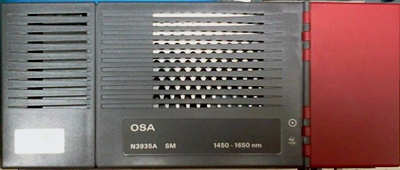
|
|
The Agilent N3935A DWDM (dense wavelength division multiplexing) Optical Spectrum Analyzer N3935A is designed to be attached in a second onto the Modular Network Tester N3900A. Each DWDM Optical Spectrum Analyzer has built-in RISC processing power for fast and accurate trace acquisition and data processing. With the dynamic software architecture, the DWDM analysis application is uploaded in seconds and enables plug and play operation. DWDM Optical Spectrum Analyzer test engines can be exchanged and shared between multiple users without mainframe software changes, providing efficient and reliable installation and maintenance service. The DWDM Optical Spectrum Analyzer is capable of characterizing DWDM systems in the S-, C-, and L-bands and beyond. This includes optical spectrum characterization both before and after optical amplifiers. With a scanning resolution of 0.005nm, a relative wavelength accuracy of 0.02 nm and excellent spectral dynamic range Agilent’s DWDM Optical Spectrum Analyzer is designed to be used in systems with down to 25 GHz channel spacing. Wavelength Range: 1450 nm to 1650 nm. Maximum Number of Simultaneous Channels: 256. Maximum Number of Sampling Points: 40000. Resolution Bandwidth (FWHM): <= 100 pm. Absolute Uncertainty: ±0.03 nm. Relative Uncertainty: ± 0.02 nm. Scanning Resolution: 0.005 nm. Absolute Uncertainty: ± 0.3 dB. Relative Uncertainty (versus lamda): ± 0.2 dB. Linearity (versus power): ± 0.1 dB. Power uncertainty due to polarization: ± 0.05 dB. Readout Resolution: 0.01 dB. Power Noise Level (RMS): -70 dBm. Maximum Safe Input Power: +30 dBm (Max +15 dBm per channel (0.1 nm)). Return Loss (@ 1550 nm): > 40 dB.
|